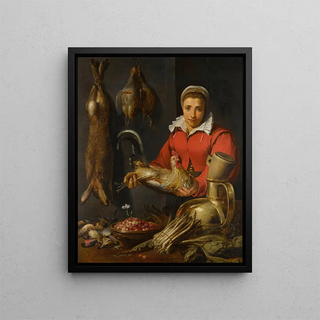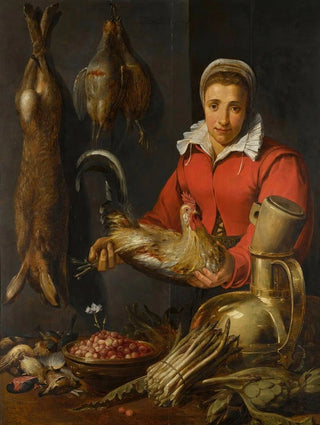Art print | A merchant holding a rooster with game, asparagus, artichokes, utensils, and a bowl of wild strawberries - Frans Snyders


View from behind

Frame (optional)
Art print of a merchant holding a rooster with game, asparagus, artichokes, utensils, and a bowl of wild strawberries - Frans Snyders – Captivating Introduction
In the vibrant world of 17th-century Flemish painting, Frans Snyders' work stands out for its liveliness and striking realism. "Art print of a merchant holding a rooster with game, asparagus, artichokes, utensils, and a bowl of wild strawberries" is a composition that immerses us in the heart of a lively market, where nature and daily life intertwine in delicate harmony. Through this scene, the artist manages to capture not only the beauty of earthly products but also the very essence of the merchants' lives of his time. This piece, a true ode to the richness of nature, invites viewers to appreciate the splendor of details, textures, and colors, while awakening a sense of nostalgia for bygone eras.
Style and uniqueness of the work
Snyders' style is characterized by a naturalistic approach, where each element is treated with impressive meticulousness. In this work, the merchant, the central figure, is depicted with an expressiveness that transcends a simple portrait. Her gaze, both proud and gentle, evokes a deep connection with the products she offers. The asparagus and artichokes, carefully arranged, seem almost tangible, while the rooster, a symbol of vitality, adds dynamism to the composition. The wild strawberries, vibrant in color, add a touch of freshness and lightness. Snyders excels in playing with light, creating delicate shadows that enhance the volume and depth of objects. Every element, whether edible or utilitarian, is highlighted, demonstrating a profound respect for nature and its offerings.
The artist and his influence
Frans Snyders, born in Antwerp in 1579, is often regarded as one of the masters of still life. His work was deeply influenced by the great masters of his time, such as Peter Paul Rubens, with whom he collaborated. Snyders developed a unique style, integrating

Matte finish

View from behind

Frame (optional)
Art print of a merchant holding a rooster with game, asparagus, artichokes, utensils, and a bowl of wild strawberries - Frans Snyders – Captivating Introduction
In the vibrant world of 17th-century Flemish painting, Frans Snyders' work stands out for its liveliness and striking realism. "Art print of a merchant holding a rooster with game, asparagus, artichokes, utensils, and a bowl of wild strawberries" is a composition that immerses us in the heart of a lively market, where nature and daily life intertwine in delicate harmony. Through this scene, the artist manages to capture not only the beauty of earthly products but also the very essence of the merchants' lives of his time. This piece, a true ode to the richness of nature, invites viewers to appreciate the splendor of details, textures, and colors, while awakening a sense of nostalgia for bygone eras.
Style and uniqueness of the work
Snyders' style is characterized by a naturalistic approach, where each element is treated with impressive meticulousness. In this work, the merchant, the central figure, is depicted with an expressiveness that transcends a simple portrait. Her gaze, both proud and gentle, evokes a deep connection with the products she offers. The asparagus and artichokes, carefully arranged, seem almost tangible, while the rooster, a symbol of vitality, adds dynamism to the composition. The wild strawberries, vibrant in color, add a touch of freshness and lightness. Snyders excels in playing with light, creating delicate shadows that enhance the volume and depth of objects. Every element, whether edible or utilitarian, is highlighted, demonstrating a profound respect for nature and its offerings.
The artist and his influence
Frans Snyders, born in Antwerp in 1579, is often regarded as one of the masters of still life. His work was deeply influenced by the great masters of his time, such as Peter Paul Rubens, with whom he collaborated. Snyders developed a unique style, integrating






